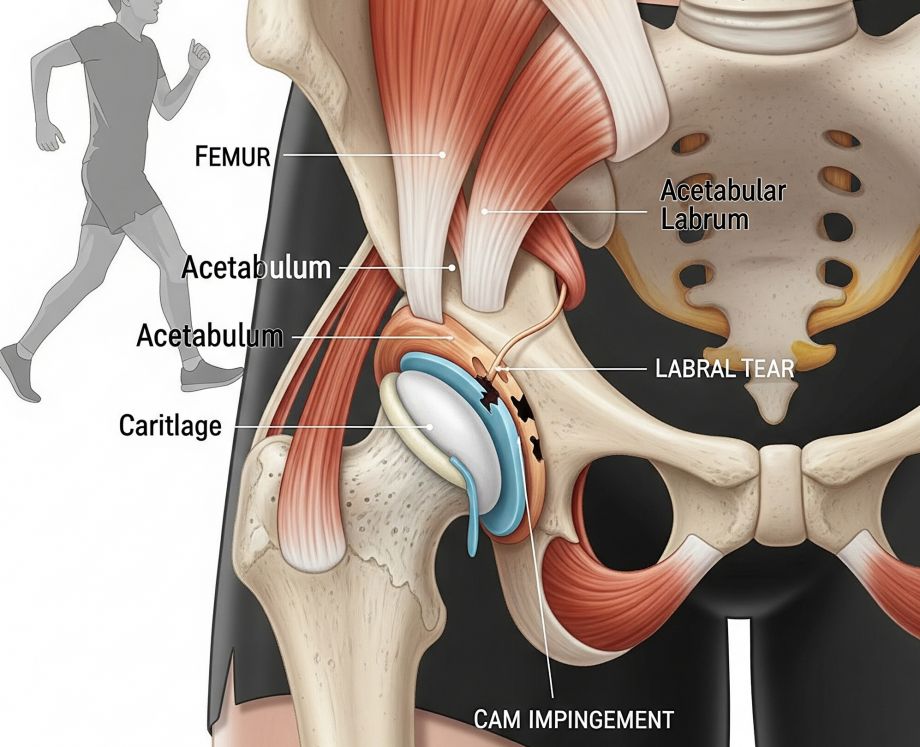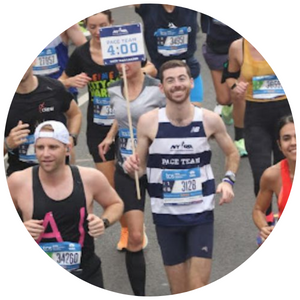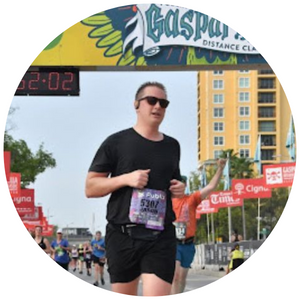Hip Labral Tears: A Runner’s Guide to Rehab and Returning to the Pavement

A hip labral tear can be a frustrating and painful injury, especially for runners. It can feel like a sudden stop sign on your running journey, but with the right approach, it doesn’t have to be the end. This guide, and a run coach, can help you tailor a customized training plan and walk you through the essential steps for recovery, from initial rehab to building a strong foundation with runners’ strength training, so you can safely and confidently return to the sport you love.
Understanding the Injury
First, let’s understand what a hip labral tear is. The hip joint is a ball-and-socket joint, and the labrum is a ring of cartilage that lines the socket. It acts like a gasket, providing stability, cushioning, and a smooth surface for the thigh bone to move. A tear in this cartilage can be caused by repetitive motion (common in running), a traumatic injury, or structural abnormalities in the hip. The result is often a deep, dull ache in the groin or front of the hip, a catching or locking sensation, and a general loss of range of motion.
The Path to Recovery: Non-Surgical vs. Surgical
The recovery process for a hip labral tear is highly individualized and depends on the severity of the tear, the presence of other issues like femoroacetabular impingement (FAI), and your personal goals.
Non-Surgical Recovery
For minor tears or when surgery isn’t an option, a non-surgical approach focuses on managing symptoms and building a strong, stable hip. This typically involves:
- Rest and Activity Modification: The first and most crucial step is to stop or significantly reduce activities that cause pain, especially high-impact ones like running.
- Physical Therapy (PT): A specialized physical therapist will create a plan to strengthen the muscles that support your hip, including the glutes, core, and deep hip rotators. This helps to provide the stability that the torn labrum can no longer provide. You may be prescribed exercises like bridges, side planks, and single-leg strength work.
- Pain Management: Over-the-counter NSAIDs, like ibuprofen, or a doctor-administered corticosteroid injection can help reduce pain and inflammation, allowing you to participate more effectively in physical therapy.
- PRP (Platelet-Rich Plasma) Injections: A newer, non-surgical option that some runners explore is PRP therapy. This regenerative treatment involves drawing a small amount of your own blood, processing it to concentrate the platelets and growth factors, and then injecting this concentrated plasma directly into the injured area of the hip. The goal is to stimulate the body’s natural healing mechanisms, reduce inflammation, and promote tissue repair. While results can vary, PRP can be a promising option for those with non-detached tears who have not found relief through other conservative treatments.
- Cross-Training: While you’re not running, you can maintain your cardiovascular fitness with low-impact activities like swimming, cycling (on a stationary bike with no resistance at first), or using an elliptical machine.
Surgical Recovery (Hip Arthroscopy)
If a non-surgical approach doesn’t provide relief, or for more severe tears, a surgeon may recommend hip arthroscopy. This is a minimally invasive procedure to repair or remove the torn part of the labrum. The recovery timeline is longer and more structured:
- Phase 1 (0-4 weeks post-surgery): The focus is on protecting the surgical repair. You will likely use crutches and a hip brace to limit weight-bearing. Gentle, passive range-of-motion exercises will be introduced by your physical therapist.
- Phase 2 (4-8 weeks post-surgery): You will gradually begin to bear weight and can often ditch the crutches. Active strengthening and balance exercises will be introduced, along with low-impact cardio like stationary biking or aquatic therapy.
- Phase 3 (8-12 weeks post-surgery): As your strength and mobility improve, the exercises will become more challenging. Your PT will introduce bodyweight squats, step-ups, and more advanced core and hip strengthening.
- Phase 4 (12-16+ weeks post-surgery): This is the final and most exciting phase. If you have progressed well, you will be cleared to begin a return-to-running protocol. This phase also includes plyometrics and agility drills to prepare your hip for the demands of running.
The Return to Running: A Progressive Approach
Regardless of your recovery path, the key to returning to running is a slow, progressive, and conservative approach. Here are some critical guidelines:
- Get clearance from your physical therapist and doctor. Do not start running until you’ve been given the green light.
- Start with a run/walk program. Begin with short intervals, such as one minute of running followed by five minutes of walking. Gradually increase the running time while decreasing the walking time.
- Listen to your body. Pay close attention to any pain or discomfort. If you experience pain that worsens during or after a run, it’s a sign to back off and potentially consult with your PT again. A little soreness is normal, but sharp or persistent pain is not.
- Avoid speed work and hills initially. Stick to flat surfaces and a comfortable pace. Introduce faster running and incline only after you have been running pain-free for an extended period.
- Strengthen, strengthen, strengthen. The work you did in physical therapy doesn’t end when you start running again. Maintaining hip and core strength is your best defense against re-injury. Incorporate exercises like single-leg bridges, lateral band walks, and planks into your weekly routine.
- Increase mileage gradually. The general rule of thumb is to increase your total weekly mileage by no more than 10%.
Long-Term Prevention
Once you are back to running, it’s essential to be proactive to prevent another injury.
- Proper warm-up and cool-down: Always warm up before a run and stretch afterward.
- Strengthen your entire kinetic chain: A strong core, glutes, and hips will support your hip joint and reduce stress.
- Avoid overstretching: Deep, aggressive stretching can put undue pressure on the labrum. Focus on gentle, controlled stretches that promote mobility without overextending the joint.
- Use proper footwear: Worn-out shoes can alter your gait and increase stress on your hips.
- Vary your running surface: Running on soft surfaces like trails or grass can be less impactful than pavement.
Recovering from a hip labral tear is a test of patience, but with a structured plan, professional guidance, and a commitment to rebuilding your strength, you can get back to doing what you love.








